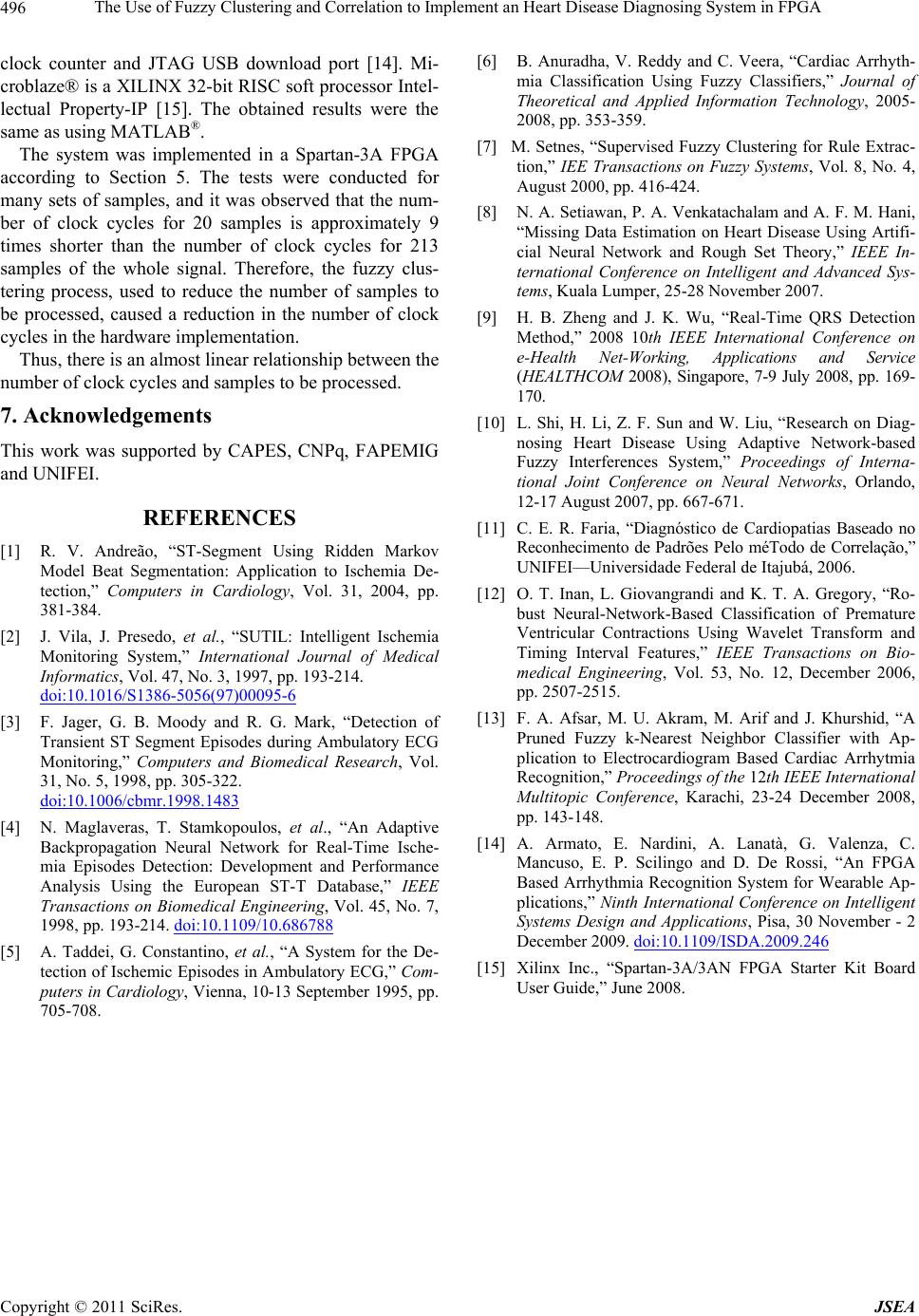
The Use of Fuzzy Clustering and Correlation to Implement an Heart Disease Diagnosing System in FPGA
Copyright © 2011 SciRes. JSEA
496
clock counter and JTAG USB download port [14]. Mi-
croblaze® is a XILINX 32-bit RISC soft processor Intel-
lectual Property-IP [15]. The obtained results were the
same as using MATLAB®.
The system was implemented in a Spartan-3A FPGA
according to Section 5. The tests were conducted for
many sets of samples, and it was observed that the num-
ber of clock cycles for 20 samples is approximately 9
times shorter than the number of clock cycles for 213
samples of the whole signal. Therefore, the fuzzy clus-
tering process, used to reduce the number of samples to
be processed, caused a reduction in the number of clock
cycles in the hardware implementation.
Thus, there is an almost linear relationship between the
number of clock cycles and samples to be processed.
7. Acknowledgements
This work was supported by CAPES, CNPq, FAPEMIG
and UNIFEI.
REFERENCES
[1] R. V. Andreão, “ST-Segment Using Ridden Markov
Model Beat Segmentation: Application to Ischemia De-
tection,” Computers in Cardiology, Vol. 31, 2004, pp.
381-384.
[2] J. Vila, J. Presedo, et al., “SUTIL: Intelligent Ischemia
Monitoring System,” International Journal of Medical
Informatics, Vol. 47, No. 3, 1997, pp. 193-214.
doi:10.1016/S1386-5056(97)00095-6
[3] F. Jager, G. B. Moody and R. G. Mark, “Detection of
Transient ST Segment Episodes during Ambulatory ECG
Monitoring,” Computers and Biomedical Research, Vol.
31, No. 5, 1998, pp. 305-322.
doi:10.1006/cbmr.1998.1483
[4] N. Maglaveras, T. Stamkopoulos, et al., “An Adaptive
Backpropagation Neural Network for Real-Time Ische-
mia Episodes Detection: Development and Performance
Analysis Using the European ST-T Database,” IEEE
Transactions on Biomedical Engineering, Vol. 45, No. 7,
1998, pp. 193-214. doi:10.1109/10.686788
[5] A. Taddei, G. Constantino, et al., “A System for the De-
tection of Ischemic Episodes in Ambulatory ECG,” Com-
puters in Cardiology, Vienna, 10-13 September 1995, pp.
705-708.
[6] B. Anuradha, V. Reddy and C. Veera, “Cardiac Arrhyth-
mia Classification Using Fuzzy Classifiers,” Journal of
Theoretical and Applied Information Technology, 2005-
2008, pp. 353-359.
[7] M. Setnes, “Supervised Fuzzy Clustering for Rule Extrac-
tion,” IEE Transactions on Fuzzy Systems, Vol. 8, No. 4,
August 2000, pp. 416-424.
[8] N. A. Setiawan, P. A. Venkatachalam and A. F. M. Hani,
“Missing Data Estimation on Heart Disease Using Artifi-
cial Neural Network and Rough Set Theory,” IEEE In-
ternational Conference on Intelligent and Advanced Sys-
tems, Kuala Lumper, 25-28 November 2007.
[9] H. B. Zheng and J. K. Wu, “Real-Time QRS Detection
Method,” 2008 10th IEEE International Conference on
e-Health Net-Working, Applications and Service
(HEALTHCOM 2008), Singapore, 7-9 July 2008, pp. 169-
170.
[10] L. Shi, H. Li, Z. F. Sun and W. Liu, “Research on Diag-
nosing Heart Disease Using Adaptive Network-based
Fuzzy Interferences System,” Proceedings of Interna-
tional Joint Conference on Neural Networks, Orlando,
12-17 August 2007, pp. 667-671.
[11] C. E. R. Faria, “Diagnóstico de Cardiopatias Baseado no
Reconhecimento de Padrões Pelo méTodo de Correlação,”
UNIFEI—Universidade Federal de Itajubá, 2006.
[12] O. T. Inan, L. Giovangrandi and K. T. A. Gregory, “Ro-
bust Neural-Network-Based Classification of Premature
Ventricular Contractions Using Wavelet Transform and
Timing Interval Features,” IEEE Transactions on Bio-
medical Engineering, Vol. 53, No. 12, December 2006,
pp. 2507-2515.
[13] F. A. Afsar, M. U. Akram, M. Arif and J. Khurshid, “A
Pruned Fuzzy k-Nearest Neighbor Classifier with Ap-
plication to Electrocardiogram Based Cardiac Arrhytmia
Recognition,” Proceedings of the 12th IEEE International
Multitopic Conference, Karachi, 23-24 December 2008,
pp. 143-148.
[14] A. Armato, E. Nardini, A. Lanatà, G. Valenza, C.
Mancuso, E. P. Scilingo and D. De Rossi, “An FPGA
Based Arrhythmia Recognition System for Wearable Ap-
plications,” Ninth International Conference on Intelligent
Systems Design and Applications, Pisa, 30 November - 2
December 2009. doi:10.1109/ISDA.2009.246
[15] Xilinx Inc., “Spartan-3A/3AN FPGA Starter Kit Board
User Guide,” June 2008.